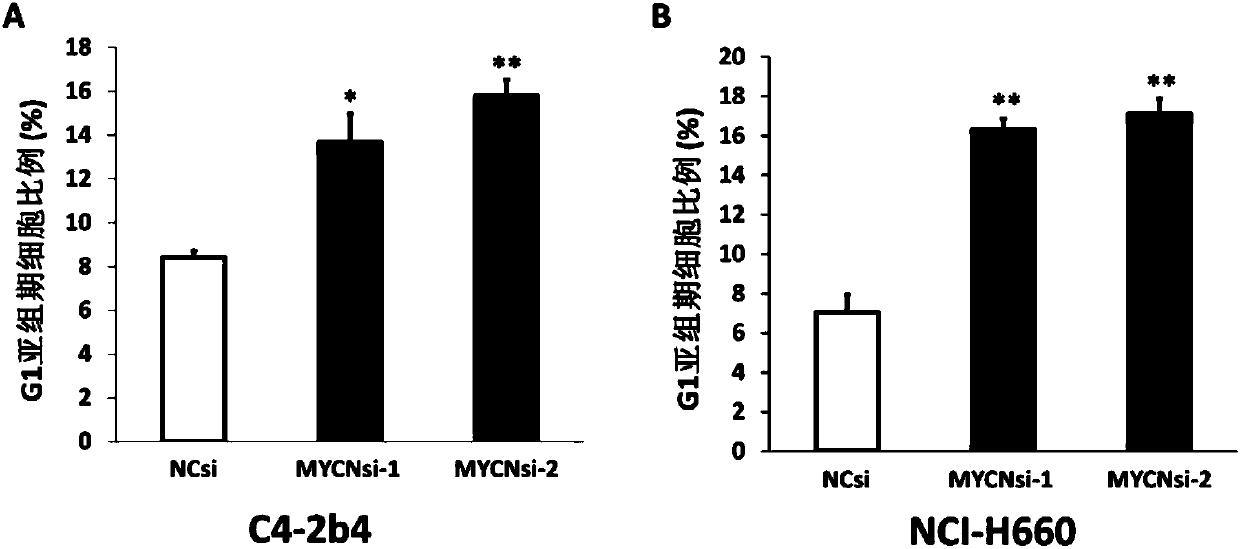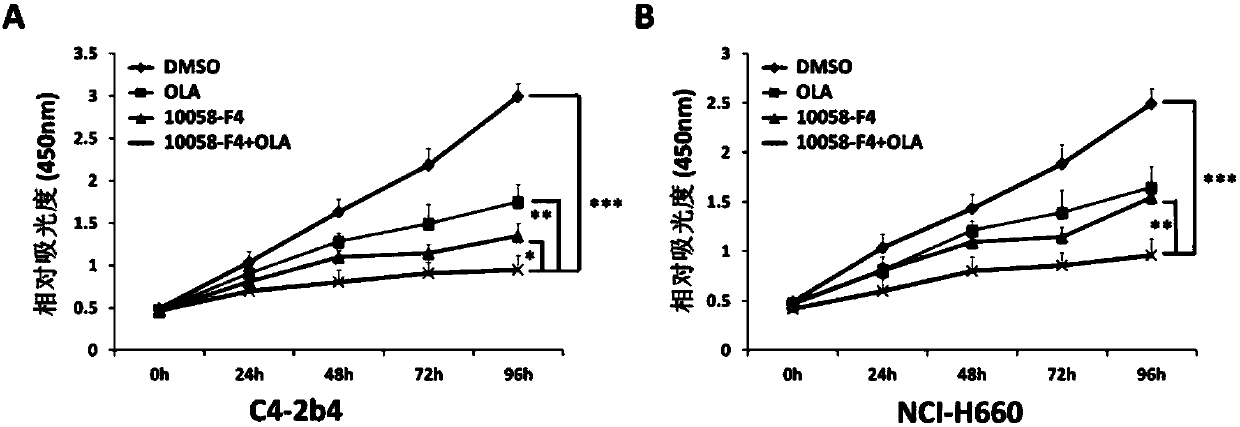Application of combination of N-Myc inhibiting agent and Olaparib to preparation of medicine for treating prostatic cancer
A technology for prostate cancer and therapeutic drugs, applied in the field of medicine, can solve the problem of difficult to inhibit the malignant progression of tumors, and achieve the effects of inhibiting proliferation and clone formation, inhibiting growth and enhancing sensitivity
- Summary
- Abstract
- Description
- Claims
- Application Information
AI Technical Summary
Problems solved by technology
Method used
Image
Examples
Embodiment 1
[0046] Spread the prostate cancer cell lines C4-2b4 and NCI-H660 in a 6-well plate, and when the cell density reached 75%, they were respectively transfected with three kinds of interfering RNA (NCsi sequence: UUCUCCGAACGUGUCACGUUU (SEQ ID NO.1); MYCNsi-1 sequence: ATGACGCTGATACATAACTAA (SEQ ID NO.2); MYCNsi-2 sequence: CGTGCCGGAGTTGGTAAAGAA (SEQ ID NO.3)). After 24 hours, transfer to 96-well plate, 4×10 per well 3 cells, with 5 auxiliary wells for each group. After the cells adhered to the wall, it was counted as 0 time, the medium was sucked off at 0, 24, 48, 72, and 96 hours respectively, and 20% MTS detection reagent diluted with the medium was added, and the 450nm at 450nm was detected after incubating at 37°C for 1 hour. Absorbance values. Growth curves were drawn using the absorbance values measured at each time point.
[0047] Depend on figure 1 In middle A, it can be seen that 48 hours after interfering with N-Myc, the proliferation rate of prostate cancer cells...
Embodiment 2
[0051] Prostate cancer cell lines C4-2b4 and NCI-H660 were grown in 6-well plates, and when the density reached about 50%, three kinds of interfering RNAs, NCsi, MYCNsi-1 and MYCNsi-2 were transfected respectively, with 3 cells in each group. Accessory hole. After 48 hours, trypsinize the cells (to avoid too long digestion time), gently blow down the cells and transfer them to a centrifuge tube, centrifuge the cells at room temperature (1000g, 5min), discard the supernatant and resuspend the cells with 300μl 1×Binding Buffer, The cells were co-stained with PI and FITC-labeled Annexin-V for 30 min at 4°C in the dark. Subsequently, the percentage of cell apoptosis was detected using the flow cytometer FACSCalibur of BD Company.
[0052] Depend on figure 2 It can be seen that after interfering with the expression of N-Myc, the apoptotic ratio of prostate cancer cells is significantly increased.
Embodiment 3
[0054] Spread the prostate cancer cell lines C4-2b4 and NCI-H660 in a 96-well plate, 4×10 per well 3 cells. After the cells adhered to the wall, they were treated with DMSO, 10058-F4 30 μM, OLA 5 μM, 10058-F4 30 μM+OLA 5 μM, and 5 auxiliary wells were set up for each group. Suck off the medium at 0, 24, 48, 72, and 96 hours respectively, add 20% MTS detection reagent diluted with the medium, and incubate at 37° C. for 1 hour to detect the absorbance at 450 nm. Growth curves were drawn using the absorbance values measured at each time point.
[0055] 10058-F4 combined with Olaparib can significantly increase the inhibitory effect of Olaparib on the proliferation of prostate cancer cells, and this level of inhibition is higher than the sum of cell inhibition caused by 10058-F4 or Olaparib alone.
PUM
 Login to View More
Login to View More Abstract
Description
Claims
Application Information
 Login to View More
Login to View More - R&D
- Intellectual Property
- Life Sciences
- Materials
- Tech Scout
- Unparalleled Data Quality
- Higher Quality Content
- 60% Fewer Hallucinations
Browse by: Latest US Patents, China's latest patents, Technical Efficacy Thesaurus, Application Domain, Technology Topic, Popular Technical Reports.
© 2025 PatSnap. All rights reserved.Legal|Privacy policy|Modern Slavery Act Transparency Statement|Sitemap|About US| Contact US: help@patsnap.com



